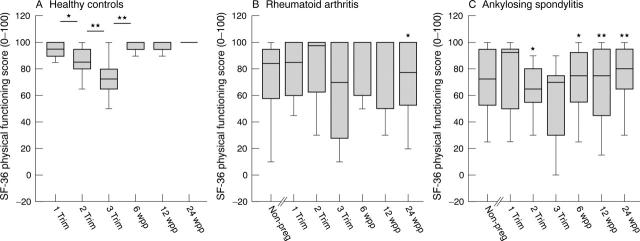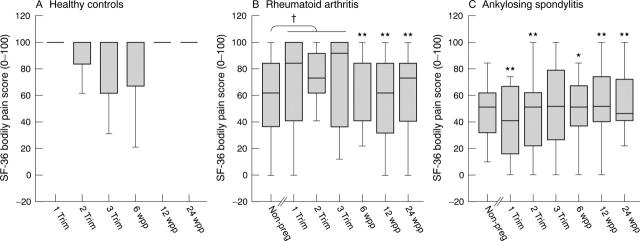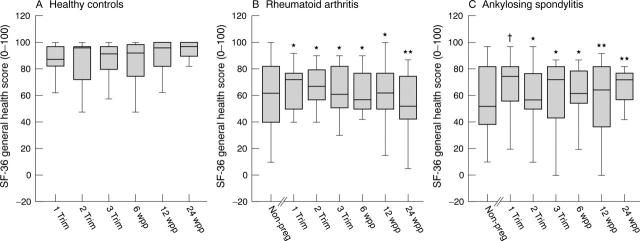Abstract
Objective: To gain insight into patient experience of the disease course and health related quality of life during and after pregnancy in women with rheumatoid arthritis and ankylosing spondylitis.
Methods: 10 patients with rheumatoid arthritis, 10 patients with ankylosing spondylitis, and 29 age matched healthy pregnant controls were evaluated by the medical outcomes study short form 36 (SF-36) health survey once at each trimester and at 6, 12, and 24 weeks postpartum. A group of non-pregnant age matched female patients (40 rheumatoid arthritis, 16 ankylosing spondylitis) was studied for comparison.
Results: Impaired physical dimensions as well as increased bodily pain was observed in healthy women in late pregnancy. Patients with rheumatoid arthritis showed improved physical functioning scores in the second trimester and reduced pain in the third trimester. Among pregnant patients, those with ankylosing spondylitis suffered the greatest impairment of health related quality of life during pregnancy. In all patient groups the physical impairment in the third trimester was less pronounced than in healthy controls. Mental health scores remained stable even with persisting active disease during pregnancy, or with a postpartum flare.
Conclusions: Pregnancy reduced physical functioning in healthy women and patients, but had no impact on mental and emotional health, even at times of disease aggravation. The pregnancy experience documented in our patients may be helpful when counselling patients contemplating pregnancy.
Full Text
The Full Text of this article is available as a PDF (83.8 KB).
Figure 1.
Short form 36 item general health survey (SF-36) physical functioning scores during and after pregnancy in healthy controls (A) and in patients with rheumatoid arthritis (B) and ankylosing spondylitis (C). SF-36 scores range from 0 to 100 (0 = worst score, 100 = best scores). Boxes represent the 25th and 75th centiles; horizontal lines within boxes represent the medians; vertical lines above and below boxes represent the distribution beyond the 25th to 75th centile range. *p<0.01 (in healthy controls, significant difference between two time points; in patients with ankylosing spondylitis and rheumatoid arthritis, significant difference from healthy controls); **p<0.001 (in healthy controls, significant difference between two time points, in ankylosing spondylitis patients, significant difference from healthy controls); non-preg = non-pregnant controls, 1 trim = 1st trimester, 2 trim = 2nd trimester, 3 trim = 3rd trimester, 6 wpp = 6 weeks postpartum, 12 wpp = 12 weeks postpartum, 24 wpp = 24 weeks postpartum.
Figure 2.
Short form 36 item general health survey (SF-36) bodily pain scores during and after pregnancy in healthy controls (A) and in patients with rheumatoid arthritis (B) and ankylosing spondylitis (C). SF-36 scores range from 0 to 100 (0 = worst score, 100 = best scores). Boxes represent the 25th and 75th centiles; horizontal lines within boxes represent the medians; vertical lines above and below boxes represent the distribution beyond the 25th to 75th centile range. *Significant difference from healthy controls at p<0.01; **significant difference from healthy controls at p<0.001; †significant difference between pooled data of pregnant patients and non-pregnant patients; non-preg = non-pregnant controls, 1 trim = 1st trimester, 2 trim = 2nd trimester, 3 trim = 3rd trimester, 6 wpp = 6 weeks postpartum, 12 wpp = 12 weeks postpartum, 24 wpp = 24 weeks postpartum.
Figure 3.
Short form 36 item general health survey (SF-36) general health scores during and after pregnancy in healthy controls (A) and in patients with rheumatoid arthritis (B) and ankylosing spondylitis (C). SF-36 scores range from 0 to 100 (0 = worst score, 100 = best scores). Boxes represent the 25th and 75th centiles; horizontal lines within boxes represent the medians; vertical lines above and below boxes represent the distribution beyond the 25th to 75th centile range. †Significant difference from healthy controls at p<0.05; *significant difference from healthy controls at p<0.01; **significant difference from healthy controls at p<0.001; non-preg = non-pregnant controls, 1 trim = 1st trimester, 2 trim = 2nd trimester, 3 trim = 3rd trimester, 6 wpp = 6 weeks postpartum, 12 wpp = 12 weeks postpartum, 24 wpp = 24 weeks postpartum.
Selected References
These references are in PubMed. This may not be the complete list of references from this article.
- Arnett F. C., Edworthy S. M., Bloch D. A., McShane D. J., Fries J. F., Cooper N. S., Healey L. A., Kaplan S. R., Liang M. H., Luthra H. S. The American Rheumatism Association 1987 revised criteria for the classification of rheumatoid arthritis. Arthritis Rheum. 1988 Mar;31(3):315–324. doi: 10.1002/art.1780310302. [DOI] [PubMed] [Google Scholar]
- Garrett S., Jenkinson T., Kennedy L. G., Whitelock H., Gaisford P., Calin A. A new approach to defining disease status in ankylosing spondylitis: the Bath Ankylosing Spondylitis Disease Activity Index. J Rheumatol. 1994 Dec;21(12):2286–2291. [PubMed] [Google Scholar]
- Gran J. T., Ostensen M. Spondyloarthritides in females. Baillieres Clin Rheumatol. 1998 Nov;12(4):695–715. doi: 10.1016/s0950-3579(98)80045-9. [DOI] [PubMed] [Google Scholar]
- Hueston W. J., Kasik-Miller S. Changes in functional health status during normal pregnancy. J Fam Pract. 1998 Sep;47(3):209–212. [PubMed] [Google Scholar]
- Kvien T. K., Kaasa S., Smedstad L. M. Performance of the Norwegian SF-36 Health Survey in patients with rheumatoid arthritis. II. A comparison of the SF-36 with disease-specific measures. J Clin Epidemiol. 1998 Nov;51(11):1077–1086. doi: 10.1016/s0895-4356(98)00099-7. [DOI] [PubMed] [Google Scholar]
- McHorney C. A., Ware J. E., Jr, Lu J. F., Sherbourne C. D. The MOS 36-item Short-Form Health Survey (SF-36): III. Tests of data quality, scaling assumptions, and reliability across diverse patient groups. Med Care. 1994 Jan;32(1):40–66. doi: 10.1097/00005650-199401000-00004. [DOI] [PubMed] [Google Scholar]
- McHorney C. A., Ware J. E., Jr, Raczek A. E. The MOS 36-Item Short-Form Health Survey (SF-36): II. Psychometric and clinical tests of validity in measuring physical and mental health constructs. Med Care. 1993 Mar;31(3):247–263. doi: 10.1097/00005650-199303000-00006. [DOI] [PubMed] [Google Scholar]
- Mckee M. D., Cunningham M., Jankowski K. R., Zayas L. Health-related functional status in pregnancy: relationship to depression and social support in a multi-ethnic population. Obstet Gynecol. 2001 Jun;97(6):988–993. doi: 10.1016/s0029-7844(01)01377-1. [DOI] [PubMed] [Google Scholar]
- Nelson J. L., Hughes K. A., Smith A. G., Nisperos B. B., Branchaud A. M., Hansen J. A. Maternal-fetal disparity in HLA class II alloantigens and the pregnancy-induced amelioration of rheumatoid arthritis. N Engl J Med. 1993 Aug 12;329(7):466–471. doi: 10.1056/NEJM199308123290704. [DOI] [PubMed] [Google Scholar]
- Ostensen M. Counselling women with rheumatic disease--how many children are desirable? Scand J Rheumatol. 1991;20(2):121–126. doi: 10.3109/03009749109165287. [DOI] [PubMed] [Google Scholar]
- Ostensen M., Husby G. A prospective clinical study of the effect of pregnancy on rheumatoid arthritis and ankylosing spondylitis. Arthritis Rheum. 1983 Sep;26(9):1155–1159. doi: 10.1002/art.1780260915. [DOI] [PubMed] [Google Scholar]
- Ostensen M., Ostensen H. Ankylosing spondylitis--the female aspect. J Rheumatol. 1998 Jan;25(1):120–124. [PubMed] [Google Scholar]
- Stucki G., Liang M. H., Stucki S., Brühlmann P., Michel B. A. A self-administered rheumatoid arthritis disease activity index (RADAI) for epidemiologic research. Psychometric properties and correlation with parameters of disease activity. Arthritis Rheum. 1995 Jun;38(6):795–798. doi: 10.1002/art.1780380612. [DOI] [PubMed] [Google Scholar]
- Talamo J., Frater A., Gallivan S., Young A. Use of the short form 36 (SF36) for health status measurement in rheumatoid arthritis. Br J Rheumatol. 1997 Apr;36(4):463–469. doi: 10.1093/rheumatology/36.4.463. [DOI] [PubMed] [Google Scholar]
- Ware J. E., Jr, Sherbourne C. D. The MOS 36-item short-form health survey (SF-36). I. Conceptual framework and item selection. Med Care. 1992 Jun;30(6):473–483. [PubMed] [Google Scholar]
- van Tubergen Astrid, Coenen Jolanda, Landewé Robert, Spoorenberg Anneke, Chorus Astrid, Boonen Annelies, van der Linden Sjef, van der Heijde Désirée. Assessment of fatigue in patients with ankylosing spondylitis: a psychometric analysis. Arthritis Rheum. 2002 Feb;47(1):8–16. doi: 10.1002/art1.10179. [DOI] [PubMed] [Google Scholar]
- van der Linden S., Valkenburg H. A., Cats A. Evaluation of diagnostic criteria for ankylosing spondylitis. A proposal for modification of the New York criteria. Arthritis Rheum. 1984 Apr;27(4):361–368. doi: 10.1002/art.1780270401. [DOI] [PubMed] [Google Scholar]
- Østensen M., Fuhrer L., Mathieu R., Seitz M., Villiger P. M. A prospective study of pregnant patients with rheumatoid arthritis and ankylosing spondylitis using validated clinical instruments. Ann Rheum Dis. 2004 Oct;63(10):1212–1217. doi: 10.1136/ard.2003.016881. [DOI] [PMC free article] [PubMed] [Google Scholar]





